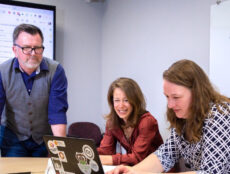
Technology has become a necessary element of learning in the modern world as more education facilities adopt digital teaching methods, such as interactive whiteboards, class blogs and game-based teaching.
In the near future, we expect most classrooms also to adopt virtual reality (VR) and augmented reality (AR) technology to simulate objects and environments, which will help children learn, as education is forecasted to be the 4th largest sector for VR investment by 2025.
VR is a computer-generated environment, perceived through a headset or helmet, that appears to be real. The immersive environment and virtual touchable objects make it easier to remember information and use knowledge in practice.
While VR is entirely virtual, AR uses real-world settings enhanced with computer-generated visuals through smartphone apps or AR Glasses. The latter is an up-and-coming tool that will layer data and graphics on top of what we naturally see.
How AR and VR can be integrated into school subjects
Using VR and AR in the classroom can increase memory power and knowledge retention, boost excitement and engagement, and reduce distractions.
VR and AR can also create safe, controlled environments to support students with learning difficulties such as dyslexia, dyspraxia, dysgraphia and attention deficit hyperactivity disorder (ADHD).
About 93% of teachers said that their students would be excited by welcoming VR into their classrooms, so here are how some school subjects could adopt VR and AR into their lesson plans:
Maths
Using AR apps, such as Shapes 3D, students can build and measure 3D shapes anywhere they like including the classroom. This allows students to learn about each shape’s complex dimensions and properties through a digital device.
Math Ninja AR can make maths fun for younger students by incorporating physical movements such as stretching, bending, squatting, crawling and reaching to find the answer.
Geography
VR headsets allow students to explore anywhere in the world, including the Seven Wonders, the Louvre Museum, the North Pole, Machu Picchu, the Moon and Mars.
Using the National Geographic Explore VR app, students can understand how different factors can affect the geography of a location, investigate how different environments can affect how people interact with them, and examine how economics and trade differ across the world.
Literacy and Languages
VR can transport students to fantasy worlds or the scene of their book to inspire their writing or make it easier to understand a story they are reading.
AR-powered apps, such as Mondly, allow students to learn a new language or develop their existing language skills with the help of a virtual assistant. Using AR, these apps can tailor their learning plans to suit each student’s needs based on their strengths and weaknesses.
Physical Education
Whatever the weather, VR headsets can bring the sports field to the classroom so that students can practise their techniques, develop teamwork skills, and learn more about a sport and those who play it.
Science
VR apps can transform the way students learn about human and animal anatomy.
Students can virtually hold a human heart, inspect cells, and tour the human body using Complete Anatomy 2023. They can also dissect a frog and examine the body without harming an animal using VR Frog Dissection.
History
Similar to the transporting powers of VR in Geography classes, students can also use the technology as a time machine to observe significant world events, visit historical sites and immerse themselves in different eras.
Through the King Tut app, students can also view and investigate a range of historical artefacts up close, such as an Egyptian pharaoh of the 18th dynasty, Tutankhamun.
Art
VR allows students to visit famous art galleries, such as the Louvre in Paris, to see sculptures and paintings up close. It also lets students explore other art forms, such as street art.
Students can use art AR apps to create their own art and discover emerging art forms, such as 360 photography and sketching. World Brush allows students to paint by moving their device through the air, whilst Assemblr lets students create highly detailed 3D objects.
Future of Technology in the Classroom
VR and AR are empowering students to take learning beyond the classroom by offering lessons and experiences that would not be possible without these technologies.
By integrating traditional teaching methods with immersive technology, educators are on track to revolutionise how students learn and explore their world.
Through immersive and engaging experiences, VR and AR give students a greater understanding of course material and helps them to build soft skills such as leadership, time management and teamwork.
With the technologies rapidly developing and becoming more available, it’s just a matter of time before education facilities adopt VR and AR into their lesson plans.
If you enjoyed this article, why not check out Essential Skills in Social Work?
Featured image: Tirachard, iStock.








5 Comments